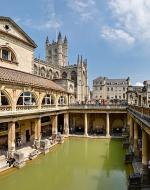Created by Sierra Windham on Thu, 11/14/2019 - 12:36
Description:
Along with the Goddess Sulis, the famous Roman Baths are continuously evoked in The Flight of Gemma Hardy. This site continues to draw tourists from all over the world and, even today, is believed to promote healing with its special waters. Jane Austen, who lived in Bath and used the location as a primary setting in some of her novels, is often celebrated here with festivities in her honor (Charlotte Brontë is similarly memorialized in Yorkshire, where people are encouraged to walk in her footsteps and explore the land she loved). Charlotte Brontë mentions Bath in a letter to Ellen Nussey: "When will you come home? Make haste! You have been at Bath long enough for all purposes; by this time you have acquired polish enough, I am sure; if the varnish is laid on much thicker, I am afraid the good wood underneath will be quite concealed, and your Yorkshire friends won't stand that" (King 143). Here we receive another glimpse at her humorous and witty voice, as well as her potential attitude towards Bath, which was known for being a hub of aristocratic activity.
As we finish reading The Flight of Gemma Hardy, let's consider the implications of Sulis and the Roman Baths. Water is an incredibly important theme in this novel: Gemma recalls her father drowning at sea, tells stories of selkies, repeatedly mentions Sulis, and escapes Mr. Sinclair by taking a boat.
Eschner, Kat. "Five Things to Know About Bath, Jane Austen's Home and Inspiration." Smithsonian, Smithsonian Institution, July 18, 2017.
Livesey, Margot. "The Flight of Gemma Hardy: a Novel." Harper Perennial, 2013.
Shorter, Clement King. "The Brontes Life and Letters: Being an Attempt to Present a Full and Final Record of the Lives of the Three Sisters, Charlotte, Emily and Anne Bronte." Cambridge University Press, New York, 2013. p. 143.
Copyright:
Associated Place(s)
Part of Group:
Artist:
- DAVID ILIFF


